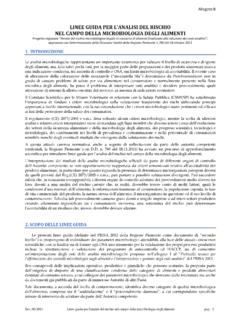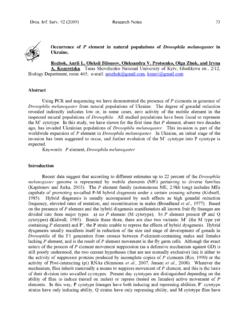Transcription of Social and emotional learning for children with …
1 ISSN 2073-7629 100 2017 CRES Special Issue Volume 9, Number 2, November 2017 pp Special Issue Volume 9, Number 2, November 2017 pp 100 - 109 Discussion Paper Social and emotional learning for children with learning Disability: Implications for inclusion. Valeria Cavioni1, Ilaria Grazzani and Veronica Ornaghi. Department of Human Sciences for Education, University of Milano-Bicocca, Milan, Italy. This paper discusses the key role of Social and emotional learning programmes for children with learning Disability (LD).
2 The first part of the paper discusses the difficulties students with learning disability may encounter in their education, such as issues related to peer group acceptance, friendship and Social isolation, low self-efficacy and self-esteem, and externalized and internalized behavior problems. The relationship between Social and emotional learning programmes and learning disability is then discussed, underlining the benefits of Social and emotional learning for students with LD. The paper concludes by highlighting the need for universal Social and emotional learning as a vehicle for the academic and Social inclusion of students with LD.
3 Keywords: Social and emotional learning , learning disability, inclusion, universal intervention First submission 11th September 2017; Accepted for publication 26th October 2017. Introduction Students with learning Disability (LD) are identified through difficulties in academic work, mainly reading, writing, and/or calculation difficulties (also called Specific learning Difficulties or Specific learning Disorder (American Psychiatric Association, 2013). Consequently, the usual emphasis of intervention for these students has mainly focused on the development of effective programmes to support learning processes, targeting the areas of reading, writing or counting, with little attention to the emotional and Social aspects.)
4 1 Corresponding author. Email address: ISSN 2073-7629 101 2017 CRES Special Issue Volume 9, Number 2, November 2017 pp However, school problems encountered by students with LD are not limited to areas that only related to learning processes, such as attention and memory. Various studies have highlighted a number of issues related to the emotional and Social aspects of education of children with LD (Butler & Silliman, 2008; Elias, 2004; Schiff & Joshi, 2016).
5 According to the DSM-5 (American Psychiatric Association, 2013) Specific learning disorders can have negative functional consequences across the lifespan, including [..] high levels of psychological distress and poorer overall mental health. School dropout and co-occurring depressive symptoms increase the risk for poor mental health outcomes, including suicidality (p. 73). This paper discusses the influence of LD on the emotional and Social development of children at school and argues on the importance of increasing school-based SEL programmes to promote the Social and emotional development of such students Social , emotional and behavior challenges for students with LD Rejection, isolation, and peer pressure Bryan's first studies (Bryan, 1974a; 1974b.)
6 1976) and following research described the sociometric status of children with LD as one characterized by isolation and Social rejection across time (Kavale & Forness, 1996; Magalit & Al-Yagon; 2002; Ochoa & Olivarez, 1995; Swanson & Malone, 1992; Tur Kaspa, 1999). children who are less chosen by peers at school, have fewer opportunities to interact and build friendships and tend to experience frequent states of loneliness (Mugnaini, Lassi, La Malfa & Albertini, 2009; Pearl et al., 1998), showing poor prosocial behaviour and emotional distress (Wentzel, Barry, & Caldwell, 2004).
7 Conversely, having positive relationships with classroom peers leads to a better psychological adjustment (Bagwell, Newcomb, & Bukowski, 1998; Schneider, Wiener, & Murphy, 1994). Other studies pointed out that, although some students with LD may be able to easily join Social groups, these groups are more frequently characterized by behavioural problems and lower levels of prosocial behaviour. Furthermore, adolescents with LD tend to show more willingness to conform to negative peer pressure to engage in risk-behaviours ( , substance and alcohol abuse, unprotected sexual activity, delinquency and gambling) to avoid Social isolation and to support friends' requests and wishes (Bryan, Werner, & Pearl, 1982; Bryan, Pearl, & Fallon, 1989).
8 These behaviours are considered as an effective way to be accepted by peers (McNamara, Vervaeke, & Willoughby, 2008). Isolation, conflict, and difficulties in creating and maintaining Social relationships (Bakker, Denessen, Bosman, Krijgert, & Bouts, 2007; Val s, 1999; Yu, Zhang, & Yan, 2005) can lead students to build friendships with those who are rejected by peers such as students with behavioural problems, with similar learning difficulties or younger children (Wiener, 2002; Wiener & Schneider, 2002).
9 This may represent an additional obstacle to the development of Social competence, turning away children with LD from the mainstream peer group. Low Self-efficacy and self-esteem Research has indicated that the self-efficacy and self-esteem of children with LD may be negatively influenced by classroom isolation, by the difficulties of dealing with school demands and by repeated experiences of school failure (Zeleke, 2004). children with LD tend to compare their performance with that ISSN 2073-7629 102 2017 CRES Special Issue Volume 9, Number 2, November 2017 pp of their peers and consider themselves different, less valued and less skilled (Gadeyne, Ghesqui re, & Onghena, 2004; Humphrey & Mullins; 2002).
10 Feelings of discomfort, anxiety, and frustration are often associated with failure experiences in school demands such as reading aloud in front of the classmates or in situations when traditional teaching methodologies based purely on writing-reading skills. Such situations negatively impact the learning motivation and engagement of students with LD, with students avoiding to engage in activities that require any sort of academic effort or skills (Nelson & Harwood, 2011). Social , emotional and behavioural difficulties Students with LD seem to be less accurate in recognizing expressions of emotions such as anger, fear, joy, and embarrassment (Wiig & Harris, 1974), showing more difficulties in correctly interpreting Social situations and in predicting the behavioural consequences of specific actions (Bruno, 1981; Saloner & Gettinger, 1985).

















